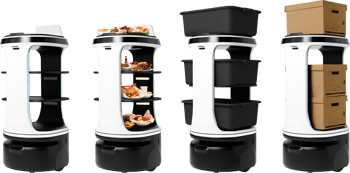For restaurant operators contending with low morale, burnout, and high turnover, nothing is off the menu. They’re rethinking wages, offering creative new benefits, and working harder than ever to build empowering and supportive workplace cultures.
But what about restaurant design? Have you thought about how your floor plan and environmental factors affect your staff’s performance and morale?
Expert Tips for Employee-Friendly Restaurant Design
We spoke to two restaurant layout and design experts to get their best tips for ways your physical restaurant space can keep employees happy. And a happy staff has all kinds of benefits, from lower turnover to improved customer service.
The experts we talked to were:
- Allison Cooke, partner and director of hospitality design at CORE Architecture + Design
- Linda Callahan, director of Next Step Design
They shared plenty of advice for employee-friendly restaurant design, covering everything from floor to ceiling for both first-time and veteran operators.
1. Build Your Floor Plan With Safety and Comfort in Mind
Employee-friendly restaurant design starts at the bottom. “Design through ergonomics,” says Cooke, “plays a huge role in employee satisfaction.” Ergonomics refers to the science of arranging spaces and objects in a way that they can be used safely and efficiently.
Moving Around
You can’t open a restaurant without a floor plan, so Cooke recommends you start planning for your employees’ well-being there. Think about how you can arrange both the front and back of house to minimize unnecessary back and forth. A well thought-out layout can, for example, help make sure bartenders aren’t taking five steps to get ice when it should be in arm’s reach.
Try to visualize your restaurant staff occupying the space and performing their daily tasks. Cooke suggests that even operators with limited budgets can benefit from closely observing their restaurant workflows.
“Look at where the server’s going most frequently,” she says. “Are there blind corners they’re going to turn? If a bus person’s dropping dishes, are they going to run into someone expediting food from the kitchen?” Careful attention to your layout can help avoid common pain points like these and keep things flowing smoothly.
Standing Still
Comfort is just as important. For restaurant employees who spend entire workdays on their feet, anti-fatigue mats are an industry standard. Designed to improve circulation and alleviate lower-body stress, these mats aren’t much to look at, but operators should consider them a must-have as they deck out their restaurants.
When it comes to placing mats, Callahan encourages operators to work directly with plumbing engineers to find the right locations to keep them from becoming tripping hazards. Avoid placing them near drains or troughs or on sections of the floor with steep slopes.
2. Use Natural Light Strategically
Everybody likes a little extra sunlight, but windows are expensive to install and much easier to dirty up than they are to clean. Back-of-house glass gets greasy especially fast, so windows put an extra burden on your already-busy kitchen staff.
Callahan warns against placing windows too close to cooking equipment. She suggests skylights and transom windows as great low-maintenance options for kitchen areas. Cook agrees. “A transom is a slimmer window that’s up higher on the wall,” she explains. Since it’s high on the wall, it leaves space for storage and prep areas on the wall below it.
Though you can’t open transoms to let in the breeze, you’ll find they’re less pricey than other options. A window you can’t open is far better than no window at all!
If you don’t have the wall-space or funds to fill your kitchen with natural light, don’t leave your back-of-house staff in the dark. Callahan notes that the right dining area windows will let at least some natural light through to your kitchen.
3. Cut Down on Sensory Overload
Too much natural light can be a problem at the front of the house. Your customers may not mind bright light throughout their meals if it means a nice view, but asking your front-of-house employees to withstand glare and direct sunlight for their whole shifts is another matter.
“We’re always thinking about visual fatigue and employees’ sight lines,” says Cooke. For restaurants with lots of big windows and natural light, this may mean looking into various shading devices to minimize and manage glare.
Don’t forget about sound fatigue. Kitchens and restaurant dining rooms are naturally loud. When these spaces aren’t designed with acoustics in mind, the noise can grow overwhelming. Where should operators start their acoustical redesigns? Cooke advises them to look up and consider their ceilings.
“With an exposed ceiling,” Cooke elaborates, “there’s a spray-on acoustical solution, and then there are acoustical large-format panels that can be pinned to the underside of structure, or you could do a dropped acoustical system.”
Materials like drapes and upholstery can also dampen excess noise to keep decibel levels tolerable across your eatery’s more lively spaces.
4. Bring Down the Temperature
If you can’t stand the heat, stay out of the kitchen? That’s tough in a restaurant! Temperature control is an essential part of employee-friendly restaurant design.
While kitchens always get hot, the right ventilation will keep your staff from taking their breaks in the walk-in freezer. Installing the right HVAC system may set you back, but it beats losing half your back-of-house staff after your restaurant’s first sweltering summer.
Consider make-up air, which replaces the air that’s sucked up through the hoods over your cooking areas instead of just blowing the same hot air onto your line cooks. Make-up air gets pulled in from outside, either directly during cooler months or after being cooled by an air-conditioner during warmer months.
Cooke encourages operators to “[Go] the extra mile” and cool down their make-up air. Blowing 100-degree air back into the restaurant on a hot day won’t do much to improve comfort levels.
5. Designate Employee-Specific Areas
Your staff shouldn’t have to settle for turning a back or side alley into a makeshift break room. Whether they’re looking for a quick breather or a chance to unwind with their peers after a busy shift, creating dedicated employee spaces shows you care about employee-friendly restaurant design by giving everyone a place to de-stress, re-energize, and unwind.
Callahan notes that operators in certain jurisdictions are now legally obligated to provide at least a locker room for their staff. Why stop at just a locker room? She suggests using any mandated employee space for multiple purposes. “If you have to take up space for lockers anyway, we encourage clients to turn it into a break room,” Callahan says.
Some of those clients go the extra mile, “creat[ing] larger spaces that allow for dining – a place for shift meal or family meal.” If you can spare a little more space, consider a staff-only bathroom too.
6. Implement the Right Technology To Make Everyone’s Lives Easier
Your tech stack goes a long way in smoothing out day-to-day operations. The right solutions deployed across the front and back of house can help address common frustrations for both your customers and staff.
Opting for a handheld POS (point of sale) system, for example, dramatically reduces the number of steps your servers take each shift. Cooke describes the benefits of a mobile POS, saying, “A lot of our clients use Toast’s system, and the staff love it . . . they’re not having to go back and forth to the POS constantly.”
Stay on Top of Trends
To learn about the latest in restaurant operations and how operators are affected by current events, sign up for the Back of House newsletter and get weekly updates sent directly to your inbox.





